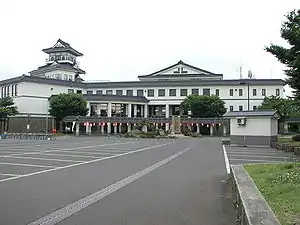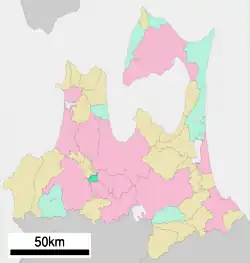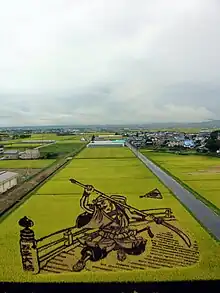Inakadate
田舎館村 | |
|---|---|
 Inakadate Village Hall | |
 Flag  Seal | |
Location of Inakadate in Aomori Prefecture | |
 | |
 Inakadate | |
| Coordinates: 40°37′52.1″N 140°33′08″E / 40.631139°N 140.55222°E | |
| Country | Japan |
| Region | Tōhoku |
| Prefecture | Aomori |
| District | Minamitsugaru |
| Area | |
| • Total | 22.35 km2 (8.63 sq mi) |
| Population (January 31, 2023) | |
| • Total | 7,420 |
| • Density | 330/km2 (860/sq mi) |
| Time zone | UTC+9 (Japan Standard Time) |
| Phone number | 0172-58-2111 |
| Address | 1 Nakatsuji, Inakadate-mura, Minamitsugaru-gun, Aomori-ken 038-1113 |
| Website | Official website |

Inakadate (田舎館村, Inakadate-mura) is a village in Aomori Prefecture, Japan. As of 31 January 2023, the village had an estimated population of 7,420 in 2845 households,[1] and a population density of 362 persons per km2. The total area of the village is 22.35 square kilometres (8.63 sq mi).
Geography
Inakadate occupies the flatlands within Minamitsugaru District of south-central Aomori, east of the city of Hirosaki.
Neighbouring municipalities
Aomori Prefecture
Climate
The village has a cold humid continental climate (Köppen Dfb) characterized by warm short summers and long cold winters with heavy snowfall. The average annual temperature in Inakadate is 10.5 °C. The average annual rainfall is 1294 mm with September as the wettest month. The temperatures are highest on average in August, at around 24.1 °C, and lowest in January, at around -1.9 °C.[2]
Demographics
Per Japanese census data,[3] the population of Inakadate has decreased steadily over the past 60 years.
| Year | Pop. | ±% p.a. |
|---|---|---|
| 1960 | 11,509 | — |
| 1970 | 10,062 | −1.33% |
| 1980 | 10,053 | −0.01% |
| 1990 | 9,370 | −0.70% |
| 2000 | 8,835 | −0.59% |
| 2010 | 8,153 | −0.80% |
| 2020 | 7,326 | −1.06% |
History
During the Edo period, the area around Inakadate was controlled by the Tsugaru clan of Hirosaki Domain. After the Meiji Restoration, it became part of Minamitsugaru District. On April 1, 1889, Inakadate was proclaimed as a village with the establishment of the modern municipalities system. On April 1, 1955, it annexed neighboring Kodaji Village, but lost a portion of its territory to Onoe Town on October 1, 1956.
Government
Inakadate has a mayor-council form of government with a directly elected mayor and a unicameral village legislature of eight members. Minamitsugari District contributes one member to the Aomori Prefectural Assembly. In terms of national politics, the village is part of Aomori 3rd district of the lower house of the Diet of Japan.
Economy
The economy of Inakadate is heavily dependent on agriculture, notably rice and horticulture.
Education
Inakadate has one public elementary school and one public junior high school operated by the village government. The village does not have a high school.
Transportation
Railway
![]() East Japan Railway Company (JR East) - Ōu Main Line, Gono Line
East Japan Railway Company (JR East) - Ōu Main Line, Gono Line
Highway
Local attractions
- Tareyanagi Site, a Yayoi-period ruin and National Historic Site[4]
Art stimulus
In 1993, as part of a revitalization effort, Inakadate began creating rice paddy art, murals of art using rice paddy fields. The people were looking for a way to revitalize their village. Archaeology showed that rice had been grown in the area for more than 2000 years.[5] To honor this history, the villagers started a rice field behind the town hall. The villagers cultivated and used four different types[5] of heirloom and modern strains of rice to create a giant picture in the field. To allow viewing of the whole picture, a mock castle tower 22 meters high was erected at the village office.[5] In 2006, more than 200,000 people visited the village to see the art.[5]
To encourage visitation outside of rice growing season, the village began using the same fields for winter rice paddy art in 2016. The designs are created by compressing snow into patterns by walking on it with snowshoes.[6]
Notable people from Inakadate
- Tochinoumi Teruyoshi, sumo wrestler
References
- ↑ Inakadate village official statistics (in Japanese)
- ↑ Inakadate climate data
- ↑ Inakadate population statistics
- ↑ "垂柳遺跡". Cultural Heritage Online (in Japanese). Agency for Cultural Affairs. Retrieved 25 December 2017.
- 1 2 3 4 Hani, Yoko (2007-08-26). "Homegrown art". The Japan Times. Retrieved 22 February 2010.
- ↑ "Winter Rice Paddy Art and Ground Blizzard Experience". Aomori Sightseeing Guide. 26 January 2017. Retrieved 12 February 2019.
External links
- Official website (in Japanese)
- Enchanting Murals bring Japan's farm to life' September 3, 2017, NTRJournal